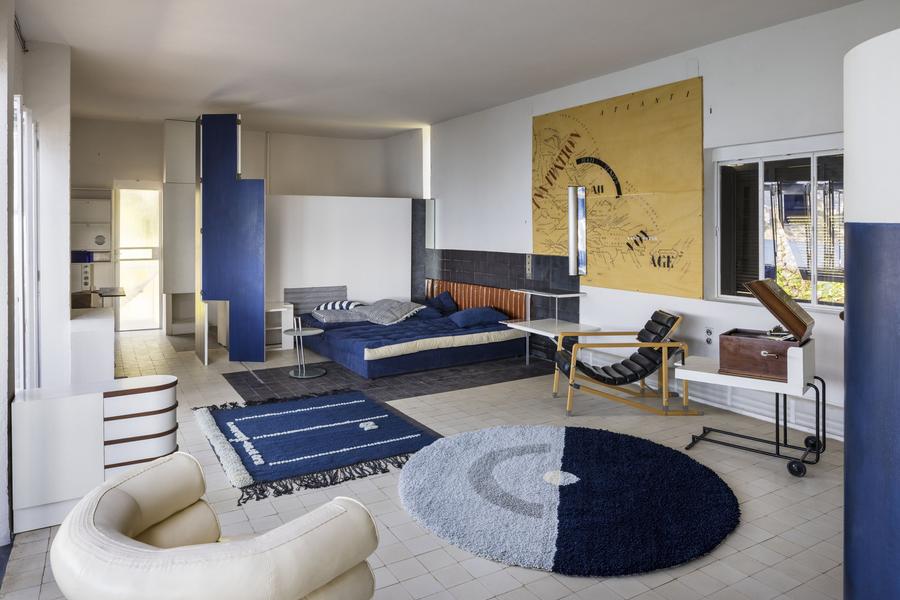Visionary Modernist Designer Eileen Gray (Finally) Gets More of the Spotlight
- November 04, 2021 19:35

Transformative modernist architecture, enduring furniture designs in museum collections and still being reproduced, and a "Dragons" armchair that, at $28.3 million, remains the most expensive piece of 20th-century design ever sold at auction, belong to a woman lesser known than her male peers. Notes The Getty: How did the legacy of Irish designer Eileen Gray become obscured?
Gray's architectural masterpiece in France—now carefully restored and a museum open to the public due to efforts by nonprofit Cap Moderne through the Getty Foundation’s Keeping It Modern initiative—along with a new exhibition in California, shed more light on her career.

In 1937 a naked Le Corbusier infamously painted eight ‘racy’ murals over the walls of Gray’s groundbreaking E-1027 house, the modernist villa that she designed on the French Riviera. In 2019 Kim Schoenstadt took this violation as a point of inspiration for her large-scale, multimedia exhibition now at ArtCenter Mullin Gallery in Pasadena, Calif.
The ArtCenter Mullin Gallery's exhibition, Kim Schoenstadt: Enter Slowly, The Legacy of an Idea, on view now through February 27, 2022, is an artistic exploration into the sordid stories, rewritten histories, and exploits that befell Eileen Gray’s career and her iconic E-1027 house in the south of France.
The exhibition provides a means to not only explore the legacy of Gray and E-1027, but also to examine issues underrepresented artists face when breaking into the field in which they are not typically represented. Conceived specifically for the Mullin Gallery, Schoenstadt’s installation consists of sculptures, wall drawings, stitched canvases, and collages inspired by the original and the subsequently misinterpreted architecture and color-block motifs of Gray’s interior. Integral to the exhibition is an assemblage of ephemera—images and texts regarding the history of E-1027—and a series of public programming. An illustrated catalogue accompanies the exhibition, representing the first monograph of Schoenstadt’s work.

In 1926 Eileen Gray began building a personal residence in Roquebrun-Cap-Martin, France to share with her lover, the architect and writer Jean Badovici. The house, given the enigmatic name E-1027—E standing for Eileen, 10 for J (Jean), 2 for B (Badovici), and 7 for G (Gray)—is now recognized as a modern masterpiece. Yet it has also, in recent years, become a symbol of injustice towards the late designer, and indicative of gender bias and discrimination towards women in professional roles. Badovici notoriously took credit as co-architect. Even more outrageously, frequent guest Le Corbusier painted over Gray's origianl designs with murals of his own (c. 1938-39). Architectural historian Beatriz Colomina compared Le Corbusier's infamous act to “...a dog peeing on street corners; he wants to make his mark by erasing hers [Gray's], by filling a white living room with colorful designs and putting his signature in a space that does not belong to him.” This gesture has been referred to as an act of vandalism and desecration, and in direct defiance of Gray’s express wish that E-1027 remain free of any decoration other than her integrated choices.

Kim Schoenstadt: Enter Slowly, The Legacy of an Idea was envisaged by Schoenstadt as less an intervention onto Gray’s masterpiece than a synthesis of memory and a rumination of error through acts of restoration and reinterpretation.
“I never lived in Gray’s head, nor can I ever understand how she would respond to the house,” says Schoenstadt. “She is a phantom and created a house that was haunted by ghosts in all genres of history, from famous architects to Nazis and soldiers during WWII, to purposeful neglect. These figures all live in the house in some way.” With this in mind, Schoenstadt’s intent is not to reproduce Gray’s work but to consider such “ghosts”—the figures that have inhabited the house—while offering an artistic interpretation that honors a visionary yet overlooked figure of 20th-century modernist architecture and design.
Kim Schoenstadt: Enter Slowly, The Legacy of an Idea was organized in support of the national Feminist Art Coalition (FAC). Initiated by Apsara diQuinzio at Berkeley Art Museum, FAC is a multi-institutional coalition presenting programs focused on themes of feminism.














_-3100x100_c.jpg)






